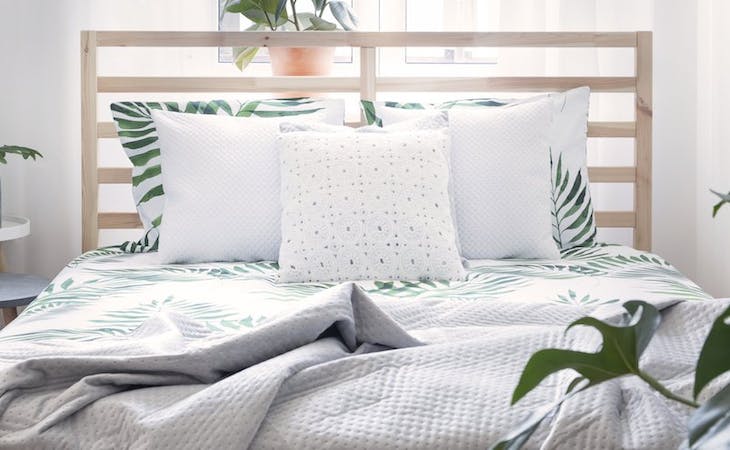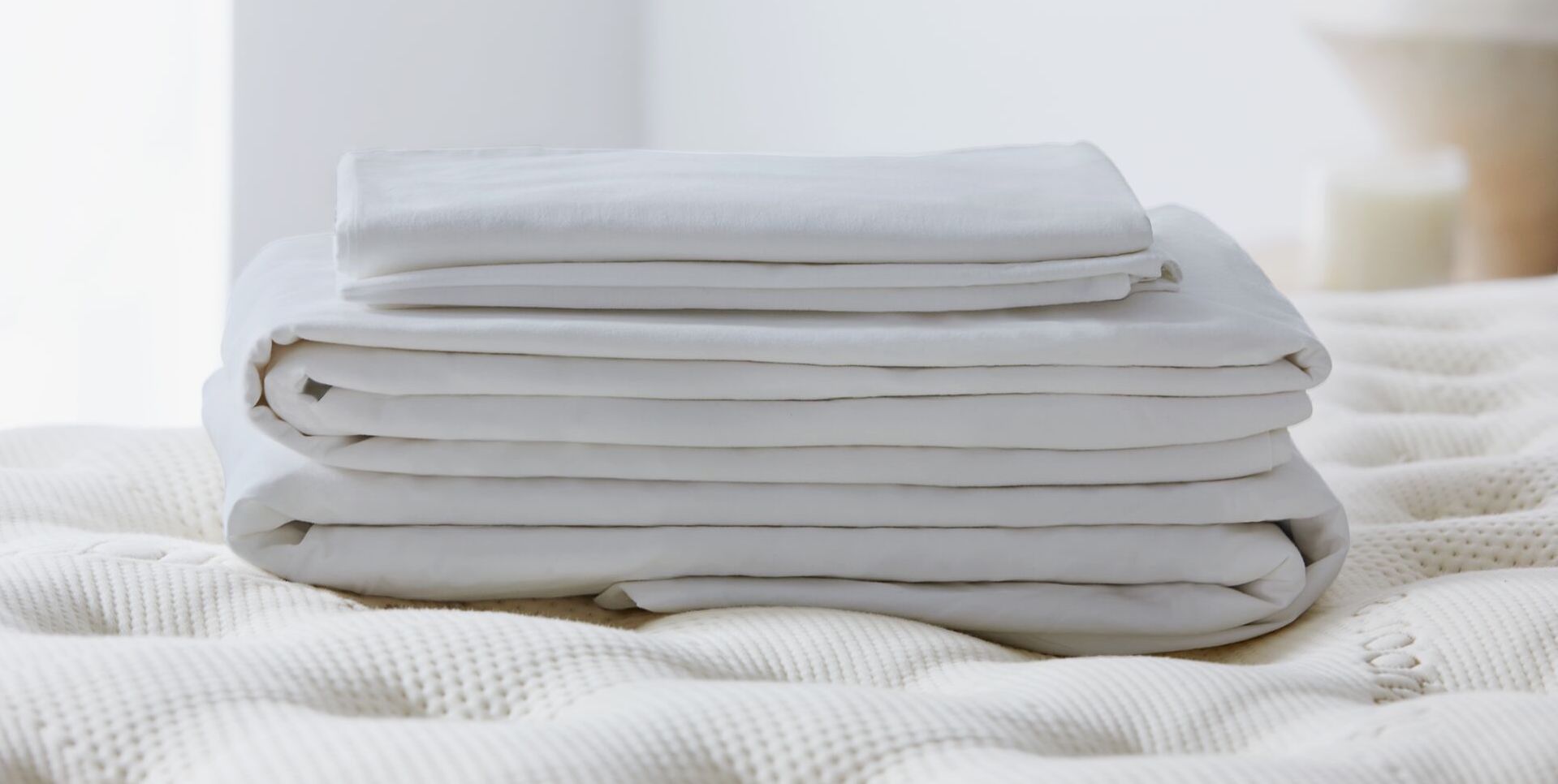Spring forward? Actually, when it comes to giving your bedroom a livelier, fresher look and feel, think segue, not leap. After all, nobody goes straight from sweaters and boots to tank tops and sandals; likewise, your bedroom needs to account for fluctuating temperatures and gradually increasing light. This is especially true when it comes to bedding itself: Swap out your heavy down comforter for a skimpy open-weave blanket and you’re bound to wake up shivering one “not so fast!” early April dawn.
How to transition your bedroom from winter to spring
Begin your bedroom transition around Daylight Savings Time (right now, essentially). “Take advantage of the time change to enhance your mood as well as your space,” says Brooklyn-based interior designer Julia Mack. “Waking up to a sunny bedroom filled with lighthearted charm will automatically make you feel happy and invigorated. Then dim the lights in the evening to a soft glow and bring a relaxed vibe to the room.”
Before switching out décor, however, do a proper spring cleaning—even if you’ve been keeping up with weekly duties all winter. “With fewer daylight hours and poorer light in general, it’s difficult to get your bedroom spotless because you literally can’t see all the dust and dirt,” says Katie Berry of HousewifeHowTos.com, author of Cleaning on YOUR Schedule.
Here are suggestions for cleaning, storage, and décor that will have your bedroom blossoming beautifully and comfortably as the season unfolds. (And here’s how to treat all your biggest spring sleep issues.)
Strip it down
Purge everything that no longer belongs in the room (a space heater, say, or that stack of books you finished). Strip all bed linens except the mattress cover (to protect the mattress while you clean). Remove art from the walls and place it on the bed for now. Remember to take down draperies or curtains, “which gather a frightening amount of dust over a year,” says Berry.
Due diligence dusting
Grab a long-handled micro-fiber duster and start at the top: ceiling, light fixture, and ceiling fan. Then move in from the threshold, dusting doors, moldings, walls, windows, and finally baseboards. Use glass cleaner on the insides of windows and all glass items. Shuck lampshades, swipe down light bulbs, and dust inside and outside the shades. Finally, dust all decorative items.
Hit the floor
Move what furniture you can to sweep and then vacuum floor areas bound to be dust bunny warrens. Make sure to get all the way under the bed. Work that crevice attachment around the base of the walls and in tight corners.
Remember the mattress
After replacing artwork, remove the mattress cover and pop it in the washer (now’s also a good time to wash your pillows). Then vacuum the top and sides of your mattress, using the upholstery attachment, and spot-treat any stains (Berry relies on baking soda and hydrogen peroxide as powerful stain fighters.)
Related: How to get any stain out of a mattress
Open the windows
“Airing out your bedroom is a great way to reduce indoor allergens and help control mold and mildew,” says Berry. “Just do it after you clean, or dust and debris will swirl and resettle on surfaces once you close the windows again.”
Launder like a pro
Wash winter linens properly, with these tips from Patric Richardson of TheLaundryEvangelist.com.
Flannel: Use warm water with a small amount of soap or detergent. Skip fabric softener or dryer sheets, which will make flannels less “lofty.”
Comforter: Whether down or polyester, a comforter needs ample room to get clean, so wash in a large, front-loading machine (hit the laundromat rather than cram a comforter into a too-small drum). Choose the express cycle on warm, with soap or down wash, and avoid fabric softener. To dry, eschew dryer sheets; pop three clean tennis balls in the machine to keep the loft in down (skip the tennis balls with a polyester comforter).
Curtains: If a washable fabric, do the job by hand in warm water with very little soap or detergent, then hang to dry.
Area rug: If cotton or braided, hand wash in the bathtub, rinse thoroughly, gently squeeze (don’t wring), and then fold over a chair back or other strong support to dry.
Related: An expert guide to cleaning every type of bedding
Stow out of sight
To store winter bedding, Richardson recommends clear plastic bags you shrink with a vacuum, so large items take up less storage space. For convenience, consider rolling bins under the bed. “If you don’t have bags, wrap bedding in an old sheet to keep dust at bay,” Richardson says, advising the addition of cedar blocks with wool blankets to discourage moths. “An interesting note about moths is that they don’t actually eat wool, but the dust and dirt on the wool—the holes are just collateral damage,” he says. “Clean fabrics naturally repel moths.”
Bring in spring colors
Trendy color combos for Spring 2020 include cherry red and light blue, chartreuse and lime, and navy with baby blue. “All add zing to a bedroom as accents—like a round rug or chair cushions in a seating area,” says Mack. And while you probably won’t repaint the whole room to suit the season, consider a fresh coat as an accent wall behind the bed. “It’s a surprising way to add style to a classic or unconventional bedroom with a very reasonable cash outlay,” Mack says. (Here are the best bedroom colors for sleep.)
Layer your linens
Key to transitioning for temperature change is a series of sheets and blankets that you’ll adjust as warmer nights come along. Mack’s preferred sequence for spring starts with breathable cotton sheets against the body, followed by a waffle-type comforter—“for that poofy, good hotel feeling,” she says—inside a 100% cotton duvet, and topped off with a wool blend blanket.
Related: The best sheets to keep you cool
Perk up your pillows
“Change throw pillows on the bed from the faux fur, velvet, and chunky wools that make it cozy in winter to lightweight, colorful cotton covers,” says Chicago-based interior designer Cynthia Espy. “No need to buy new pillow forms; just switch out the covers, which are much easier to store.” Perkier pillows are particularly nice if you prefer to keep the rest of your bed neutral.
Wake up your windows
“Morning sunlight helps us set our circadian rhythms, but it’s important to control the incoming amount,” says Mack, who favors the flexibility of two-inch horizontal tilt blinds. “Closed they still allow some brightness in, while open the sun streams through.” In a brushed metallic finish, the blinds give off a rich glow when closed. “Tasteful, with an ethereal quality, they add a subtle, contemporary sheen,” Mack says.
As an alternative, Espy suggests layering window treatments as you do bedding. “Over a foundation of mounted blackout blinds, choose either floor-to-ceiling sheers or a translucent roman shade flanked by side panel draperies,” she says. “Roman shades are ideal if long draperies won’t work due to radiators or other obstructions. Use them over blackout solar shades or honeycomb shades, so that, if you want to wake to natural light, you can leave the blackout shade up and the translucent roman shade down.”
Redo your dresser
“The top of your dresser and the wall above offer another opportunity to move the mood from winter to spring,” says Espy, who advises creating a triangle composition for interest. “Hang a mirror or painting above the dresser, with a lamp in back, to the left or right, to create a third point of light in the room—assuming there are two bedside lamps. A buffet-style lamp is the perfect height without too big of a footprint.”
On the other side, a plant or vase of fresh flowers brings life to the room. In the center, locate an attractive tray to catch the detritus of the day: earrings, watch, coins, phone. “It’s a stylish way to contain clutter,” Espy says.
Related: How to stage your bedroom so buyers will love it
Don’t forget the fireplace
“Even in warm weather, your fireplace is an excellent focal point,” Mack points out. “Place a large, low plant like a fern in the hearth or a big vase filled with branches.” Change up the mantel too. If you display family photos, swap out dark wood and serious portraits for fun frames and vacation snaps. Alter collections as well, bringing in lighter shades and fun themes. A clear bowl filled with sea glass will catch the light, catch the eye—and surely bring a smile.
Add a fresh piece of furniture
While you won’t be replacing bedroom furniture every season, one new piece, such as a small table or chest, can make a huge difference. “Nothing suits warmer weather and lots of light like wicker and rattan,” Mack says. Or find a whimsically patterned slipcover for a chair and shade for a lamp to spice up a sitting area.
Let it grow
One of Espy’s favorite ways to add accent color for spring is with plants. An arrangement of greenery on stands near a sunny window is ideal. “Choose pots in shades that wink at the colors of your throw pillows across the room,” she says. And of course, flowering bulbs—potted hyacinth, tulips, and daffodils, for instance—virtually sing “spring!”
Bonus: Some plants can even help you catch more Z’s. Here are the best plants to improve your sleep.






